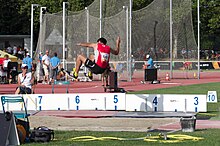Portal:Sport of athletics/Selected article/12
The long jump is a track and field event in which athletes combine speed, strength and agility in an attempt to leap as far as possible from a takeoff point. Along with the triple jump, the two events that measure jumping for distance as a group are referred to as the "horizontal jumps". This event has a history in the ancient Olympic Games and has been a modern Olympic event for men since the first Olympics in 1896 and for women since 1948. (Full article...)

There are five main components of the long jump: the approach run, the last two strides, takeoff, action in the air, and landing. Speed in the run-up, or approach, and a high leap off the board are the fundamentals of success. Because speed is such an important factor of the approach, it is not surprising that many long jumpers also compete successfully in sprints. Classic examples of this long jump / sprint doubling are performances by Carl Lewis and Heike Drechsler.
| More selected articles |

